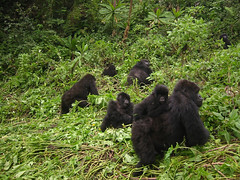I've got FOAF in my genes...
 ...or perhaps more accurately, in my brain.
...or perhaps more accurately, in my brain. As those of you who read this blog regularly know, I believe that the mythology of cyberspace often serves only to muddy our thinking about the new reality of our networked world. I think this is particularly true of the discussion around "social networking". Our online social networks are more similar to the villages and tribal groupings our anscestors created than they are different. One of the ways in which they are similar is their size. Neither smoke signals nor broadband internet access has substantially changed this fundamental aspect of human behavior, at least not yet.
 In fact, there is a specific number that has been suggested as the maximum number of interpersonal relationships that a human can reasonably maintain, Dunbar's number, which is 147.8. Dunbar (a researcher at the University College of London hypothesizes:
In fact, there is a specific number that has been suggested as the maximum number of interpersonal relationships that a human can reasonably maintain, Dunbar's number, which is 147.8. Dunbar (a researcher at the University College of London hypothesizes:
...there is a cognitive limit to the number of individuals with whom any one person can maintain stable relationships, that this limit is a direct function of relative neocortex size, and that this in turn limits group size. ...(this) group size... would require as much as 42% of the total time budget to be devoted to social grooming. (...) My suggestion, then, is that language evolved as a "cheap" form of social grooming, so enabling the ancestral humans to maintain the cohesion of the unusually large groups demanded by the particular conditions they faced at the time.
Christopher Allen has some interesting observations to add about how that group size might be effected by the introduction of modern communications technologies:
Ultima Online provides one of the best examples of what sizes an online community will support because it's well documented and the overall game size is large enough to generate many smaller communities. If you look at Raph Koster's statistics for the size of groups in Ultima Online, you will see a definite point of diminishing returns at around 150; however, you will also see that most groups are around 60 large.
I note, with some interest, that the number here is smaller, and not larger, than Dunbar's  number. It doesn't seem like the additional communication modalities (if you like) afforded to us by the internet is having a significant impact on our ability to do the "social grooming" that Dunbar postulates as the limiting factor on the size of our social networks. We seem to still be developing the set of non-verbal cues we take for granted in face to face communications - emoticons are hardly a precision instrument for social grooming - so perhaps our networks get "looser" (when their primary context is online), but apparently not broader. To me, the interesting question is not whether these relationships are "better" or "worse" (they're simply different), but to what new use shall we adapt them, once we've gotten over the idea that they are an analog for "off-line" relationships?
number. It doesn't seem like the additional communication modalities (if you like) afforded to us by the internet is having a significant impact on our ability to do the "social grooming" that Dunbar postulates as the limiting factor on the size of our social networks. We seem to still be developing the set of non-verbal cues we take for granted in face to face communications - emoticons are hardly a precision instrument for social grooming - so perhaps our networks get "looser" (when their primary context is online), but apparently not broader. To me, the interesting question is not whether these relationships are "better" or "worse" (they're simply different), but to what new use shall we adapt them, once we've gotten over the idea that they are an analog for "off-line" relationships?
 This post is Del.icio.us!
This post is Del.icio.us! Subscribe via RSS
Subscribe via RSS
